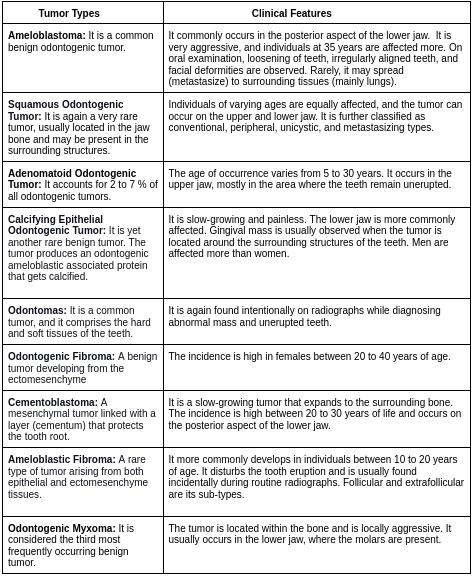Introduction:
Have you ever wondered where our teeth come from? The answer is, the tooth structure and its apparatus usually arise through the interaction between ectoderm (give rise to tooth enamel) and ectomesenchyme (produces structures other than enamel) tissues. This article reviews the various tumors arising from the tissues that form teeth and their structures.
What Are Odontogenic Tumors?
The odontogenic tumor is an abnormal mass developed from the ectoderm or ectomesenchyme that gives rise to the teeth and surrounding structures. However, the exact cause of the odontogenic tumors is still a mystery. They are mostly benign (non-cancerous) and rarely spread to surrounding tissues (malignant).
How Is It Classified?
The recent classification of the benign odontogenic tumors by the World Health Organization (WHO) is listed below:

What Are the Clinical Features?

What Are the Radiological Findings?
It is essential to understand specific terms before getting into their radiographic features.
-
Unilocular: Single cavity or compartment.
-
Multilocular: It consists of many cavities.
-
Radiolucent: Areas that appear dark in the X-rays.
-
Radiopaque: Refers to areas that appear dense (resist the passage of light) in X-rays.
-
Ameloblastoma - The tumor presents as multilocular, and one of its types known as unicystic ameloblastoma shows a radiolucent margin covering the crown portion of an unerupted tooth.
-
Squamous Odontogenic Tumor - A triangular-shaped radiolucency is visualized between the teeth and is unilocular.
-
Adenomatoid Odontogenic Tumor - It presents as small radiopaque areas within the single radiolucent mass.
-
Calcifying Epithelial Odontogenic Tumor - Calcified areas are observed within the radiolucent mass. It varies from radiolucent to radiopaque areas around the unerupted tooth.
-
Ameloblastic Fibroma - The radiolucent areas are visualized around the misplaced teeth.
-
Odontomas - It is often diagnosed incidentally and shows calcified tooth-like structures surrounded by a radiolucent margin.
-
Cementoblastoma - The margins of the tumor appear as a radiolucent rim covering a mass around the tooth root.
What Are Malignant Odontogenic Tumors?
The benign odontogenic tumor rarely spreads to surrounding tissues. The characteristic features include pain, rapid growth, and loss of sensation.
Few of the malignant odontogenic tumors are listed down:
-
Ameloblastic Carcinoma - Individuals over 45 years of age are usually affected, and on examination, abnormal voice, pain, swelling, and difficulty in jaw motions are observed.
-
Sclerosing Odontogenic Carcinoma - It rarely occurs and is usually present in the molar region of the lower jaw and destroys the surrounding bone.
-
Odontogenic Sarcoma - The incidence is high in adults over 30 years of age. An expanding growth that causes pain and altered sensation in the lower jaw is usually reported.
How Are Odontogenic Tumors Treated?
The odontogenic tumors are diagnosed with various imaging techniques like X-rays, computed tomography (CT), or magnetic resonance imaging (MRI) and through biopsy (a sample of tissue is surgically removed for examination). Then, the treatments are planned accordingly depending on the clinical and radiographic features.
-
Enucleation: The whole tumor is surgically removed, leaving behind the surrounding tissues intact. It is done for benign tumors, and the recurrence is relatively high.
-
Wide Excision: The tumor is surgically removed and the surrounding tissues to reduce its recurrence rate.
-
Radiotherapy: High-frequency radiation is targeted on the tumor site to reduce its size and control its progression.
-
Chemotherapy: Certain drugs are used to destroy the tumor cells. It is usually followed after surgical excision.
Conclusion:
The occurrence of odontogenic tumors are few and far between. The prognosis depends on the type of tumor and the treatment provided. Generally, the recurrence is low in benign tumors after complete excision. It is advisable to consult a dental surgeon for any abnormal swelling and pain in your jaw to diagnose the condition and differentiate it from tumors.












